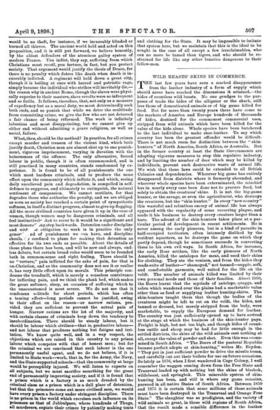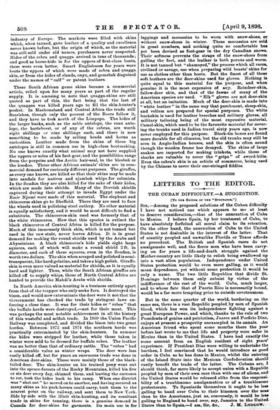WILD BEASTS' SKINS IN COMMERCE.
THE last few years have seen a marked disappearance from the leather industry of a form of supply which should never have reached the dimensions it attained,—the hides of countless wild beasts. No one grudges to the pur- poses of trade the hides of the alligator or the shark, still less those of domesticated animals or of big game killed for food. But for more than twenty years there have come to the markets of America and Europe hundreds of thousands of hides, destined for the commonest commercial uses, stripped from wild animals which have been killed for the value of the hide alone. Whole species have been butchered to the last individual to make shoe-leather. To say which country has been the greatest offender would be difficult. There is not much room for distinction between the " skin- hunters " of North America, South Africa, or Australia. But in the former country at least the State Governments are adopting vigorous measures to stop this repulsive industry, and by limiting the number of deer which may be killed by individuals, prevent such destructive waste of animal life. We wish that these laws could be extended to all British Colonies and dependencies. Wherever big game has entirely disappeared from districts where it formerly abounded, and wherever whole species have been exterminated, the mischief has in nearly every case been done not to procure food, but solely to obtain the creatures' skins. It is not the big-game hunter, or the savage, or even the agriculturist, who destroys the creatures, but the "skin-hunter." In every "new country" this wasteful and relentless enemy of animal life has always appeared with the regularity of some recurring plague, and made it his business to destroy every creature larger than a hare. The advent of the skin-hunters takes place at a par- ticular period of development in recent settlements. He is never among the early pioneers, but is a kind of parasite in half-occupied territories, often intensely disliked by the resident squatters, as he destroys the game on which they partly depend, though he sometimes succeeds in converting these to his own evil ways. In South Africa, for instance, the early Boer settlers, like the early pioneers of North America, killed the antelopes for meat, and used their skins for clothing. They ate the venison, and from the hides they made snits of leather—" shamoyed," not tanned—supple, soft, and comfortable garments, well suited for the life on the veldt. The number of animals killed was limited by their own personal needs and those of their families. About 1850, the Boers learnt that the myriads of antelope, quagga, and zebra which wandered over the plains had a marketable value other than as food or supplying leather hunting-shirts. The skin-hunters taught them that though the bodies of the creatures might be left to rot on the veldt, the hides, not tanned or dressed, but merely stripped from the body, were marketable, to supply the European demand for leather. The country was just sufficiently opened up to have arrived at the stage at which the business of the skin-hunter pays. Freight is high, but not too high, and though bides of count- less cattle and sheep may be had for little enough in the settled districts, the skins of the wild animals cost nothing at all, except the value of powder and shot. Even this was econo- mised in South Africa. "The Boers of the pastoral Republic became perfect adepts at skin-hunting," writes Mr. Bryden. "They put in just sufficient powder to drive the missile home, and carefully cut out their bullets for use on future occasions. So lately as 1876, when I first wandered in Cape Colony, I well remember the waggon coming down from the Free State and Transvaal loaded up with nothing but the skins of blesbok, wildebeest, and springbok. This miserable system of skin. hunting has been, and still is where any game remains, pursued in all native States of South Africa. Between 1850 and 1875 it is certain that some millions of these animals must have been destroyed in the Transvaal and Orange Free State." The slaughter was so prodigious, and the variety of wild animals so great, in these wild regions of South Africa, that the result made a sensible difference in the leather
industry of Europe. The markets were filled with skins which, when tanned, gave leather of a quality and excellence never known before, but the origin of which, as the material was still sold under old names, purchasers never suspected. Hides of the zebra and quagga arrived in tens of thousands ; and good as horse-hide is for the uppers of first-class boots, these were even better. Smart Englishmen for years wore boots the uppers of which were made of zebra and quagga skin, or from the hides of elands, onyx, and gemsbok disguised under the names of " calf " or patent leathers.
These South African game skins became a commercial article, relied upon for many years as part of the regular supply. It is amusing to note that quagga-skins are still quoted as part of this, the fact being that the last of the quaggas was killed years ago to fill the skin-hunter's poaket. In Mashonala.nd and Central Africa the trade still flourishes, though only the poorest of the Boers follow it, and they have to trek north of the Limpopo. The hides of the larger bucks, such as the sable antelope, the roan ante- lope, the hartebeest, or of any of the zebras, are worth eight shillings or nine shillings each, and there is now something to be made by selling heads and horns as curiosities. Leather made from the skins of these big antelopes is still in common use in high-class bootmaking. No one knows exactly what animal may not have supplied the uppers or soles of his foot-gear. and the possibilities range from the porpoise and the Arctic hair-seal, to the blesbok or the koodoo. Three other African animals' skins are in com- mercial demand for curiously different purposes. The giraffes, as every one knows, are killed so that their skins may be made into sandals for natives and sja.mbok whips for colonists. in the Soudan they are also killed for the sake of their hides, which are made into shields. Many of the Dervish shields captured during their attempt to invade Egypt under the Emir Njumi were made of this material. The elephant and rhinoceros skins go to Sheffield. There they are used to face the wheels used in polishing steel cutlery. No other material is equally satisfactory, and it would be most difficult to find a substitute. The rhinoceros.skin used was formerly that of the white rhinoceros. Now that this species is extinct the black rhinoceros of Central Africa is killed for the purpose. Much of this immensely thick skin, which is not tanned but used in the raw state, never leaves Africa. It is in great demand for making the round shields used by the Arabs and Abyssinians. A black rhinoceros's hide yields eight large squares, each of which will make a round shield 2 ft. in diameter, and each of these squares, even in the Soudan, is worth two dollars. The skin when scraped and polished is semi- transparent, like hard gelatine, and takes a high polish. Giraffe- skin is even more valued as material for shields, as it is equally hard and lighter. Thus, while the South African giraffes are killed off to supply whips, those of North Central Africa are hunted to provide the Mahdi's Arabs with shields.
In North America skin-hunting is a business entirely apart from that of the trapper who only seeks furs. It destroyed the bison, and would now exterminate the deer were it not that the Clovernment has checked the trade by stringent laws en- forcing a close time. It was for their hides or " robes " that the buffalo herds were destroyed,—not for their meat. This was perhaps the most notable achievement in all the history of this wasteful and selfish trade. In 1869 the Union Pacific Railway was completed, and divided the bison into two great hordes. Between 1872 and 1874 the southern horde was practically exterminated by the skin-hunters. In summer the hides were stripped for leather, while those taken in winter were sold to be dressed for buffalo robes. The leather was no better than that of ordinary cattle. The " robes " had a considerable value as winter wraps. The deer were less easily killed off, but for years an enormous trade was done in American deer-skins. These were mainly those of the black- tailed deer. The skin-hunter on his trained pony went out into the spruce-forests of the Rocky Mountains, killed his five or six deer every day, skinned them, and leaving the carcases to rot, took the hides back to his camp. When one district was "shot out" he moved on to another, and having secured as many skins as his pack-horses could carry, took them to the nearest point on the railway, and sent them to New York. Side by side with the illicit skin-hunting, and its resultant trade in skins for tanning, there is a genuine demand in Canada for deer-skins for garments. Its main use is for
leggings and mocassins to be worn with snow-shoes, or without snow-shoes in winter. These mocassins are sold in great numbers, and nothing quite so comfortable has yet been devised as foot-gear in the dry Canadian snows. Their softness prevents the straps of the snow-shoes from galling the feet, and the leather is both porous and warm. It is not tanned but " shamoyed," the process which all races, civilised or savage, use when preparing wild beasts' skins for use as clothes other than boots. But the finest of all these soft leathers are the deer-skins used for gloves. Nothing is quite equal to this material for the purpose, and when genuine it is the most expensive of any. Reindeer-skin, fallow-deer skin, and that of the fawns of many of the American species are used. " Elk " gloves are not deer-skin at all, but an imitation. Much of the deer-skin is made into "white leather" in the same way that parchment, sheep-skin, and vellum are prepared for special purposes. The white buckskin is used for leather breeches and military gloves, all military tailoring being of the most expensive material. Camel-skin, which used to be the favourite material for cover- ing the trunks used in Indian travel sixty years ago, is now never employed for this purpose. Block-tin boxes are found more durable for all climates, but the old trunks may still be seen in Anglo-Indian houses, and the akin is often sound though the wooden frame has decayed. The skins of large snakes are imported for making trinkets, while those of sharks are valuable to cover the " grips " of sword-hilts. Even the cobra's skin is an article of commerce, being used by the Chinese to cover their one-stringed fiddles.



































 Previous page
Previous page